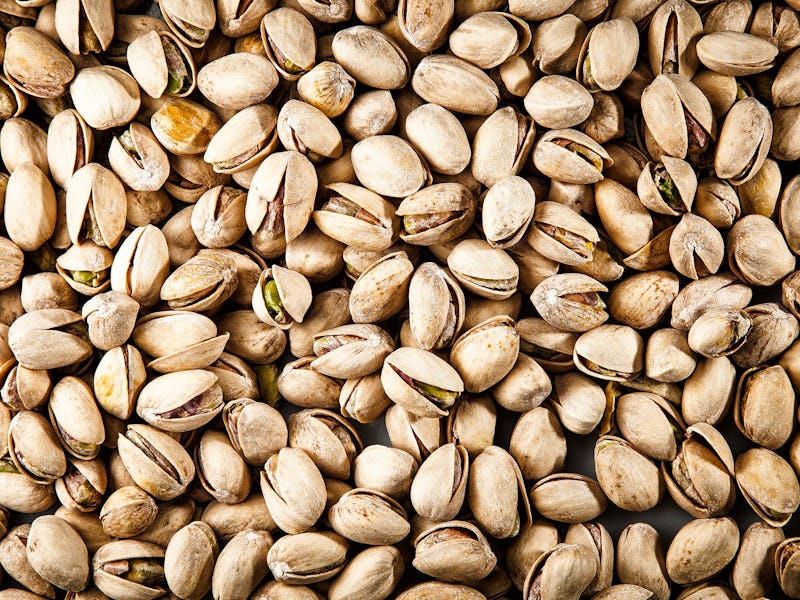A 27-year project on 117,136 people suggests diversity in this one food category is key
Plus: China's hypersonic missiles

A group of scientists last week presented their analysis of data from 117,136 participants in two massive studies of healthcare professionals that tracked their health outcomes over 27 years.
Their finding: “The type of fat and different food sources of fat are more important than the total amount of dietary fat in the prevention of cardiovascular disease including stroke.”
Pass the pistachios.
In addition to that good fat, we’ve got hypersonic missiles, your favorite show getting a reboot, and asteroids exhibiting odd movements for you. It’s all in this Monday morning edition of Inverse Daily. I’m Nick Lucchesi. Thanks for joining us.
Read more on that lead story below. Also, the seven-day average of new Covid-19 cases is more than 74,128 in the United States as of November 11. If you’ve not yet got your vaccine, vaccines.gov will quickly show you where to protect yourself against Covid-19. Get the shot and protect yourself, and the vulnerable people in your community.
This is an adapted version of the Inverse Daily newsletter for Monday, November 15, 2021. Subscribe for free and earn rewards for reading every day in your inbox. ✉️
Good fat vs. bad fat
[By Nick Keppler]
Increasing your uptake of fat from vegetable sources and decreasing the amount from red meat is the takeaway from research presented this week at the American Heart Association’s Scientific Sessions.
The researchers, led by Fenglei Wang, a postdoctoral fellow at the Harvard T.C. Chan School of Public Health, analyzed data from 117,136 participants in two hulking studies of healthcare professionals that tracked their health outcomes over 27 years.
The participants completed questionnaires to track the amount, source, and types of fat in their diets. The research is preliminary, the study has not yet been published, and is the latest to tackle the contentious subject of “good fats” versus “bad fats.”
Related:
A Chinese military band conductor stands in front of band members at a ceremony marking the 100th anniversary of the Communist Party on July 1, 2021 at Tiananmen Square in Beijing, China.
China's hypersonic missiles
[By Jon Kelvey]
Summer 2021 saw two events that, in the words of U.S. General Mark Miley, chairman of the Joint Chiefs of Staff, might be the 21st century equivalent of the “Sputnik moment” that kicked off the space race and catalyzed the Cold War nuclear arms race.
But rather than a contest between the U.S. and former USSR, Miley was referring to recent reporting by the Financial Times that China launched two nuclear-capable hypersonic missile tests in July and August.
In the August test, a Long March rocket boosted an unknown vehicle into low-Earth orbit, which later re-entered and glided — at very high speed — toward a target, although it missed by more than 10 miles.
Related:
Disney+ Day
[By Jacob Kleinman]
It’s been two years since Disney+ first launched. Is your life better now than it was back then? Due to extenuating circumstances outside the company's control, the answer is probably no, but that doesn’t mean Disney isn’t trying its hardest to make our lives a little more enjoyable.
From Star Wars to Marvel to National Geographic, Disney+ is chock-full of original shows and movies, and that list is only getting longer. On November 12, 2021 (aka, Disney+ Day), the company announced a clown car’s worth of projects. Here’s your rundown of every single new series, movie, documentary, and animated short revealed by Disney.
Read the full story and see all the new shows.
Related:
An asteroid’s “doing something weird”
[By Passant Rabie]
Benjamin Sharkey, a Ph.D. student at the University of Arizona, began looking at a small, nearby space rock named Kamo'oalewa in 2017. At visible wavelengths, Kamo'oalewa was your average near-Earth asteroid. But once Sharkey began observing it in infrared light, things started to get weird.
“So when we were observing at visible wavelengths ... we're sort of saying, okay, this is an asteroid that we've kind of seen before,” Sharkey tells Inverse. “As we kept looking in the infrared, that was the process where we went, ‘Hold on, this is doing something weird.’”
Kamo'oalewa had similar light spectra to those of samples of the Moon brought to Earth by the Apollo mission. This suggests that the asteroid may have once been a part of Earth’s Moon, and was later ejected by an ancient impact.
Related:
The Intel 4004 chip, which debuted on November 15, 1971.
- About the newsletter: Do you think it can be improved? Have a story idea? Want to share a story about the time you met an astronaut? Send those thoughts and more to newsletter@inverse.com.
- On this Day: After Federico Faggin completed creation of the Intel 4004 microprocessor, Intel took the revolutinoary invention public with an advertisement in the magazine Electronic News. Faggin was the first to fit a general-use CPU on a commercially available silicon chip, and the first customer was Busicom, which used the chip in an engineering calculator. It was the first in a continuing line of CPU chips that now control much of everything we do.
- Song of the Day: “Pistachio” by GL